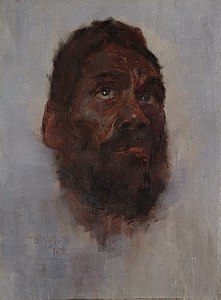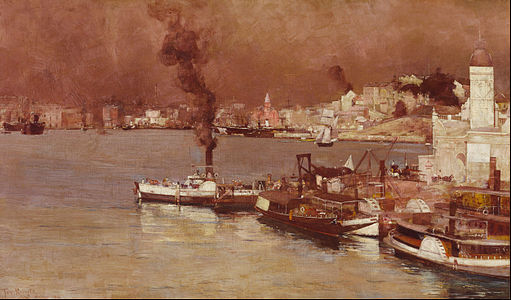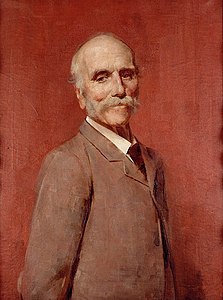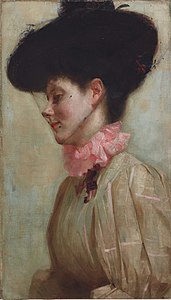Morning Light Elioth Gruner Art Gallery of New South Wales
| Tom Roberts | |
|---|---|
 Roberts, c. 1895 | |
| Born | 8 March 1856 (1856-03-08) Dorchester, Dorset, England |
| Died | fourteen September 1931(1931-09-14) (anile 75) Kallista, Victoria, Commonwealth of australia |
| Resting identify | Illawarra churchyard, near Longford, Tasmania |
| Occupation | Artist |
| Spouse(south) | Elizabeth (Lillie) Williamson (m. 1896–1928) Jean Boyes (m. 1928–1931) |
| Parent(s) | (Father) Richard Roberts (Mother) Matilda |
Thomas William Roberts (8 March 1856 – 14 September 1931) was an English-born Australian creative person and a key member of the Heidelberg Schoolhouse fine art movement, also known every bit Australian impressionism.
After studying in Melbourne, he travelled to Europe in 1881 to further his training, and returned home in 1885, "primed with whatever was the latest in art".[1] A leading proponent of painting en plein air, he joined Frederick McCubbin in founding the Box Loma artists' army camp, the start of several plein air camps frequented by members of the Heidelberg Schoolhouse. He also encouraged other artists to capture the national life of Australia, and while he is best known today for his "national narratives"—among them Shearing the Rams (1890), A break abroad! (1891) and Bailed Up (1895)—he earned a living every bit a portraitist, and in 1903 completed the commissioned work The Large Picture, the most famous visual representation of the first Australian Parliament.
Life [edit]

Roberts was born in Dorchester, Dorset, England, although some mystery surrounds his actual birthdate: his birth certificate says 8 March 1856, whereas his tombstone is inscribed ix March.[2]
Roberts migrated with his family to Australia in 1869 to alive with relatives. Settling in Collingwood, a suburb of Melbourne, Victoria. He worked as a photographer'south assistant through the 1870s, while studying fine art at night under Louis Buvelot and befriending others who were to get prominent artists, notably Frederick McCubbin.
During this period, his mother had remarried to a human being whom Roberts did not go on with. He hence decided to further his fine art studies, and returned to England for three years of full-time fine art written report at the Purple Academy Schools from 1881 to 1884. He traveled in Kingdom of spain in 1883 with Australian creative person John Russell, where he met Castilian artists Laureano Barrau and Ramon Casas who introduced him to the principles of Impressionism and plein air painting.[2] While in London and Paris, he took in the progressing influence of painters Jules Bastien-Lepage and James Abbott McNeill Whistler.[2]
From 1884 and through the 1890s Roberts worked again in Victoria, in his studio at the famous studio complex of Grosvenor Chambers at ix Collins Street, Melbourne. In 1885 he started painting and sketching excursions to what would later get outer suburbs, creating camps at Box Hill and Heidelberg, where he worked alongside McCubbin, Arthur Streeton and Charles Conder, working on representing Commonwealth of australia's light, heat, infinite and altitude.[2]

In 1896 he married 36-year-onetime Elizabeth (Lillie) Williamson and they had a son, Caleb. Many of his most famous paintings come from this menstruation. Roberts was an expert maker of picture frames, and during the period 1903–1914, when he painted relatively little, much of his income apparently came from this work. Roberts spent World War I in England profitable at a infirmary. In Australia, he built a firm at Kallista, near Melbourne. Elizabeth died in January 1928, and Roberts remarried, to Jean Boyes, in August 1928. He died in 1931 of cancer in Kallista most Melbourne. His ashes are buried in the churchyard at Illawarra near Longford, Tasmania .
Work [edit]

Roberts painted a considerable number of fine oil landscapes and portraits, some painted at artist camps with his friend McCubbin. Possibly the nearly famous in his time were 2 large paintings, Shearing the Rams, now displayed in the National Gallery of Victoria and The Big Picture, displayed in Parliament House, Canberra. The Big Pic, a delineation of the first sitting of the Parliament of Commonwealth of australia, was an enormous work, notable for the event depicted as well as the quality of Roberts' work.
Shearing the Rams was based on a visit to a sheep station at Brocklesby in southern New Due south Wales, depicted the wool industry that had been Australia's first export manufacture and a staple of rural life. When it was first exhibited, at that place were immediately calls for the painting to enter a public gallery, with a Melbourne correspondent for the Sydney press stating, "if our national gallery trustees were in the to the lowest degree patriotic, they would purchase it."[3] Some critics did not feel that it fitted the definition of 'high fine art'. Nonetheless, since the wool manufacture was Commonwealth of australia's greatest export industry at the time, it was a theme with which many Australian people could identify. In this painting, as ane modern reviewer has said, Roberts put his formal art training to work, translating "the classical bronze into the lusty workers of the shearing shed".[four]
Roberts made many other paintings showing country people working, with a similar image of the shearing sheds in The Golden Fleece (1894),[five] a drover racing after sheep breaking away from the flock in A break abroad!, and with men chopping trees in Wood splitters (1886). Many of Roberts' paintings were landscapes or ideas done on pocket-sized canvases that he did very apace, such as his prove at the famous 9 by five Impression Exhibition in Melbourne, "9 by 5" referring to the size in inches of the cigar box lids on which about of the paintings were done. Roberts had more works on display in this exhibition than anyone else.

In 1888 Roberts met Conder in Sydney and they painted together at Coogee beach. The younger Conder found these painting expeditions influential and decided to follow Roberts to Melbourne subsequently that year to join him and Streeton at their artists' campsite at Heidelberg. While Conder painted Coogee Bay emphasising on the decorative qualities of class and colour, Roberts' Vacation sketch at Coogee(1888) embodies his primary focus on the landscape's natural effects.[6] Information technology is an early on testament to Roberts' plein-air 'impressionist' technique, which brought out the dominicus'due south glare on the bright bluish bounding main, bleached white sand, dry grass and spindly seaside vegetation.
Legacy [edit]
Roberts' life was dramatised in the 1985 Australian mini series One Summertime Once again.
A "lost" painting titled Rejected was featured in a 2017 episode of the BBC serial Fake or Fortune?. It was determined by experts to be a genuine Roberts, dating from his student years in London. Roberts' granddaughter considered information technology a self-portrait. If so, information technology would make it his oldest surviving self-portrait.[7] [eight]
Retrospectives [edit]
A retrospective toured Commonwealth of australia in 1996–97 and another was shown at the National Gallery of Australia from December 2015 – March 2016.[four] [9] Roberts was one of four Australian artists whose paintings featured in the Australia's Impressionists exhibition at the National Gallery, London, which ran from Dec 2016 to March 2017; it was described every bit 'the start United kingdom exhibition of its kind'. [10]
Gallery [edit]
- Tom Roberts'due south works
-

Slumbering Bounding main, Mentone, 1887, National Gallery of Victoria
-

Ancient Head, Charlie Turner, 1892, Art Gallery of New South Wales
-

An fall morning, Milson'south Point, Sydney, 1888, Fine art Gallery of New South Wales
-

Lily Stirling, 1890, National Gallery of Victoria
-

-

Edward Ogilvie, 1894–95, Tom Roberts, oil painting, State Library of New South Wales
-

Bailed Up, 1895, Art Gallery of New South Wales
-

Portrait of Florence, 1898, Art Gallery of New S Wales
See also [edit]
- Australian art
References [edit]
- ^ Diggins, Lauraine. The Australian Impressionists. Melbourne: Lauraine Diggins Fine art, 1988. ISBN 0959274340, back embrace
- ^ a b c d "Tom Roberts". AGNSW collection record. Art Gallery of New South Wales. Retrieved 6 Apr 2016.
- ^ "Melbourne Gossip". The Sydney Postal service and New S Wales Advertiser (Sydney). 19 July 1890. p. 145. Retrieved 18 March 2016.
- ^ a b McDonald, John (12 Dec 2015). "Review: John McDonald on Tom Roberts at the National Gallery of Australia, a break-abroad star". The Sydney Morning time Herald . Retrieved xiii Dec 2015.
- ^ Roberts, Tom (1894). "The Golden Fleece". AGNSW collection record. Fine art Gallery of New South Wales. Retrieved 6 April 2016.
- ^ Roberts, Tom (1888). "Holiday sketch at Coogee". AGNSW collection record. Fine art Gallery of New South Wales. Retrieved 6 Apr 2016.
- ^ Chenery, Susan (3 September 2017). "Lost for 136 years: 'fake' Tom Roberts painting bought for £7,500 could sell for $1m". The Guardian. ISSN 0261-3077. Retrieved half-dozen September 2017.
- ^ "Tom Roberts, Serial 6, Fake or Fortune? – BBC Ane". BBC . Retrieved half-dozen September 2017.
- ^ "Tom Roberts". National Gallery of Commonwealth of australia. Retrieved 13 Dec 2015.
- ^ https://www.nationalgallery.org.uk/exhibitions/past/australias-impressionists. Retrieved eight March 2021.
Further reading [edit]
- Croll, T.H. (1946) Smike to Bulldog : messages from Sir Arthur Streeton to Tom Roberts, Sydney, Ure Smith, (Sydney: Waite and Bull)
- Grey, Anne. Tom Roberts: La Vita Con Panache pp. 11–29, and Harmonic Arrangements: Tom Roberts' Painting pp. 31–58, in (2015) Tom Roberts, National Gallery of Australia, Canberra, ISBN 9780642334596
- Pearce, Barry (2000) Australian art in the Art Gallery of New Southward Wales, Art Gallery of New Southward Wales, Sydney, ISBN 0734763093
- Roberts, Tom. "Notebook, ca. 1894–1895" (1894-1895) [Notation Book]. Tom Roberts Manuscripts, Serial: MLMSS 1367, File: MLMSS 1367/3. NSW, Aus: State Library, Land Library of New Due south Wales.
- Topliss, Helen. "Roberts, Thomas William (Tom) (1856–1931)". Australian Dictionary of Biography. Australian National University. Retrieved 5 June 2007.
- Topliss, Helen (1985). A Catalolgue Raisonne Volumes I and 2. Oxford University Press, USA. p. 544. ISBN0-xix-554513-three.
External links [edit]
- Tom Roberts on Picture Australia
- Tom Roberts at the Fine art Gallery of New Due south Wales
- Tom Roberts on artistsfootsteps.com
- Tom Roberts essay at the National Gallery of Victoria
Source: https://en.wikipedia.org/wiki/Tom_Roberts
0 Response to "Morning Light Elioth Gruner Art Gallery of New South Wales"
إرسال تعليق